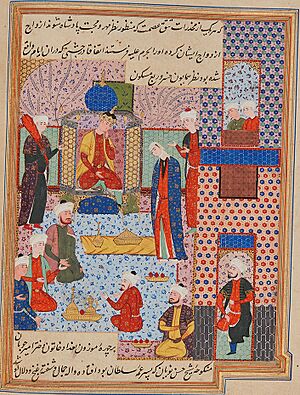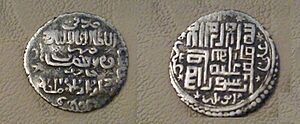Abu Sa'id Bahadur Khan facts for kids
Quick facts for kids Abu Sa'id Bahadur Khanابوسعید بهادرخان |
|||||
|---|---|---|---|---|---|
| Bahadur Khan (Valiant King) Sultan Abu Sa'id |
|||||

"In the Court of Abu Saʿid". Folio from a manuscript of Nigaristan, Iran, probably Shiraz, dated 1573-74
|
|||||
| 9th Il-Khan | |||||
| Reign | 1316–1335 | ||||
| Coronation | 1317 | ||||
| Predecessor | Öljaitü | ||||
| Successor | Arpa Ke'un | ||||
| Governor of Khorasan and Mazandaran | |||||
| Reign | 1315 - 1316 | ||||
| Predecessor | Öljaitü | ||||
| Successor | Amir Yasaul | ||||
| Born | June 2, 1305 Ujan, Tabriz |
||||
| Died | December 1, 1335 (aged 30) Karabakh |
||||
| Consort | Uljay Qutlugh Khatun Baghdad Khatun Dilshad Khatun Malika Khatun Adil Shah Khatun Sarqadaq Khatun |
||||
| Issue | Unnamed daughter | ||||
|
|||||
| House | Borjigin | ||||
| Dynasty | Ilkhanate of the Mongol Empire | ||||
| Father | Öljaitü | ||||
| Religion | Shia Islam | ||||
Abu Sa'id Bahadur Khan (born June 2, 1305 – died December 1, 1335) was an important ruler in history. He was the ninth leader of the Ilkhanate, a large part of the Mongol Empire. This empire covered areas like modern-day Iran, Azerbaijan, Georgia, and Armenia. It also included parts of Iraq, Turkey, Afghanistan, and Pakistan. Abu Sa'id ruled from about 1316 to 1335. After he died, the Ilkhanate empire began to break apart.
Contents
Early Life and Becoming Ruler
Abu Sa'id was born on June 2, 1305, near Ujan, a city close to Tabriz. His father was Öljaitü, who was the previous ruler. Abu Sa'id became the chosen heir after his older brothers passed away. In 1315, when he was still young, he was sent to govern the regions of Khorasan and Mazandaran. A wise Uyghur noble named Amir Sevinch was his guardian and helped him learn how to rule.
His Time as Ruler
In December 1316, Sevinch brought Abu Sa'id back to Soltaniyeh. However, his official crowning as ruler was delayed until sometime between April and August of 1317. This delay happened because of disagreements between two powerful nobles, Chupan and Sevinch.
Abu Sa'id chose two important advisors, called viziers, to help him govern. They were Rashid-al-Din Hamadani and Taj Al-Din Ali Shah Gilani. Unfortunately, these two viziers did not get along. This led to Hamadani being removed from his position in October 1317. Amir Sevinch, Abu Sa'id's guardian, also died in January 1318. This meant that young Abu Sa'id was now mainly guided by Chupan.
Chupan tried to bring Hamadani back to court. However, Gilani accused Hamadani and his son of poisoning Abu Sa'id's father, Öljaitü. This accusation led to their execution in July 1318. After this, Amir Chupan became the most powerful person in the Ilkhanate, almost like the real ruler. But the years that followed were full of challenges for Abu Sa'id's rule.
Facing Invasions and Rebellions
In 1319, the Golden Horde khan, Özbeg, invaded the region of Azerbaijan. This attack was planned with a prince named Yasa'ur, who had previously promised loyalty to Abu Sa'id's father but then rebelled. Abu Sa'id had to send his general, Amir Husayn Jalayir, to fight Yasa'ur. Abu Sa'id himself marched to face Özbeg. Thanks to extra soldiers sent by Chupan, Özbeg was defeated. Yasa'ur was also killed by another leader named Kebek in 1320.
Some other nobles did not help Abu Sa'id during these attacks. Because of this, Chupan punished them. Another rebellion started in 1319 by two Keraite nobles, Irinjin and Qurumishi. They were related and had been criticized by Chupan. A large rebel army surprised Chupan and his men near Georgia, forcing him to escape. Chupan reported this to Abu Sa'id, who then led his army against the rebels.
A very important battle took place on June 20, 1319, near Mianeh. Abu Sa'id's army won this battle. This victory earned the young ruler special titles: Baghatur (meaning "hero" or "warrior" in Mongolian) and al-Sultan al-Adil (meaning "the just Sultan"). After this victory, Chupan's power grew even more. He was given Abu Sa'id's sister, Sati Beg, in marriage. Chupan's sons were also given important positions as governors in different parts of the empire.
Chupan's Family Challenges
In 1322, one of Chupan's sons, Timurtash, rebelled. He even claimed to be the Mahdi, a special religious leader. Chupan personally went to convince his son to surrender. He even managed to get Timurtash reappointed to his position by Abu Sa'id.
Around this time, Abu Sa'id fell in love with Baghdad Khatun, who was one of Chupan's daughters. However, she was already married to Hasan Buzurg, another powerful noble. Chupan tried to prevent Abu Sa'id from marrying his daughter. He sent Baghdad Khatun and her husband to Karabakh. While Chupan was away fighting invaders, Abu Sa'id took the chance to have one of Chupan's other sons, Demasq Kaja, killed on August 25, 1327.
When Chupan heard this, he marched his army against Abu Sa'id to get revenge. But many important nobles, including Abu Sa'id's uncle Muhammad Beg, left Chupan's side with their soldiers. This left Chupan with no choice but to retreat. He was later killed in 1327 by another ruler, Ghiyath-uddin ibn Rukn-uddin, on Abu Sa'id's orders. Soon after, Baghdad Khatun was forced to divorce Hasan Buzurg and marry Abu Sa'id. Hasan Buzurg was then given Chupan's old job, becoming the new commander of the Ilkhanid army.
Later Years of Rule
Now that Abu Sa'id was ruling more directly, he invited Ghiyas al-Din, the son of his former vizier, to be his new chief advisor. Other powerful nobles were also given important governing roles. However, Ghiyas al-Din tried to make the central government stronger, which some nobles did not like. One noble, Narin Taghai, tried to kill Ghiyas al-Din in 1329 but was executed himself.
Later, Hasan Buzurg was also accused of plotting against Abu Sa'id with Baghdad Khatun in 1332. But he was later cleared and became governor of Anatolia. Abu Sa'id divorced Baghdad Khatun and married her niece, Dilshad Khatun, in 1333.
In 1334, Abu Sa'id appointed Amir Musaffar Inaq as governor of Shiraz. This upset Sharaf al-Din Mahmudshah Inju, who had been ruling that area. Mahmudshah chased Musaffar to Abu Sa'id's tent, accidentally making it seem like he was trying to harm the ruler. Because of this rebellious act, Mahmudshah was put in prison.
Relations with Other Countries
Abu Sa'id worked to build good relationships with other nations. In 1320, he signed a trade agreement with Venice, allowing them to set up trading posts in his empire. He also improved relations with the Mamluk Sultanate in Egypt, signing a peace treaty that same year. He even communicated with Muhammad bin Tughluq, the ruler of the Delhi Sultanate in India.
Death and What Came Next
In 1335, Abu Sa'id had to face another invasion from Özbeg. He set out to meet the invading army but died on his way in Karabakh, on the night of November 30 to December 1, 1335. His body was taken to Soltaniyeh and buried there. Some historical accounts suggest he might have been poisoned by Baghdad Khatun due to jealousy. However, it is also possible he died from the bubonic plague, a serious disease.
Abu Sa'id died without a clear heir or a chosen successor. This left the Ilkhanate empire very weak. His death led to conflicts between powerful families, like the Chupanids and the Jalayirids. The famous traveler Ibn Battuta was surprised to see how quickly the once-mighty empire fell apart after Abu Sa'id's death. The Ilkhanate lost its unity and broke into many smaller kingdoms ruled by different groups.
Key Advisors (Viziers)
Here are some of the main advisors who helped Abu Sa'id rule:
- Rashid-al-Din Hamadani (1317)
- Taj Al-Din Ali Shah (1317-1323)
- Rukn al-Din Sa'in (1323-1327)
- Ghiyas al-Din ibn Rashid al-Din (1327-1335)
Family Life
Abu Sa'id had six wives from different important families.
- His Wives
- Uljay Qutlugh Khatun (married 1317): She was the daughter of a previous ruler, Ghazan.
- Baghdad Khatun (married 1327, divorced 1333): She was the daughter of the powerful noble Amir Chupan.
- Malika Khatun
- Dilshad Khatun (married 1333): She was the niece of Baghdad Khatun.
- Adil Shah Khatun (died 1332)
- Sarqadaq Khatun: She was related to Amir Chupan.
- His Children
Abu Sa'id had one daughter:
- A daughter (born 1336): Her mother was Dilshad Khatun.
His Personality
According to the famous traveler Ibn Battuta, Abu Sa'id was known for being very handsome. He was also a cultured ruler who enjoyed the arts. He was the only Il-Khan ruler known to write his own poetry and create music.
Images for kids


